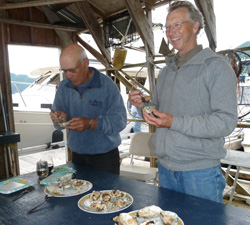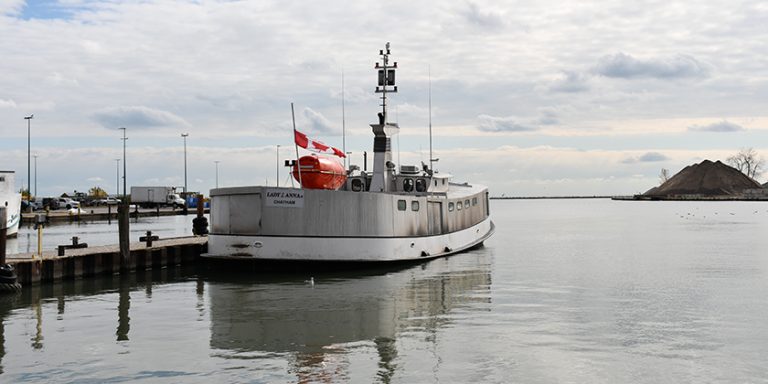Wicked Oysters

Easy to collect and prepare, fresh, wild oysters are one of the pleasures of cruising the BC coast.
One of my favourite things about cruising BC’s south coast is the local seafood. And nothing beats a few oysters!
It was late August and we opted for a dock day at Lagoon Cove Marina on East Cracroft Island because it was overcast and drizzling. We were getting to know new cruising friends at the dock, swapping stories and experiences, when I casually asked if anyone would eat a few oysters if I barbecued them. There was a combination of enthusiasm and skepticism – because oysters are not native to the Broughton Archipelago. Leaning over the stern of our sailboat, I pulled up a bucket of Desolation Sound oysters, and the party began. I prepared three versions for the barbecue and within minutes we were downing hot oysters with a glass of wine. Now that opens up the conversation.
Oyster Essentials
You will need a BC Tidal Waters Fishing License in order to collect shellfish such as oysters. The Olympia oyster is native to BC but is fairly rare in the waters of the Strait of Georgia; they are typically between five and eight centimetres in diameter. The more common non-native oysters are generally larger, typically eight to 15 centimetres, with a more irregular shell. These were introduced from Japan around 1912 and by the 1940s had spread, breeding successfully in bays and harbours throughout southern BC waters, especially in the warmer waters of Desolation Sound. Water temperatures north of Johnstone Strait are generally too cold for oysters.
Oysters are bivalves and filter feeders, meaning that whatever they have been eating, you are too. So look for them only in clean water. The two main risks of eating oysters are from sewage contamination and from Paralytic Shellfish Poisoning (PSP) which is caused by a “red tide” or an algal bloom, a common summer occurrence in the Strait of Georgia. Bays where there may be septic fields draining into the water are often posted as shellfish contamination zones. PSP can cause paralysis or death, so if in doubt as to whether there is a closure, leave the oysters for another day. Information on sewage contamination, PSP toxicity, and the resulting closures can be found on the Fisheries and Oceans Canada website (www.pac.dfo-mpo.gc.ca, search for “shellfish contamination”). Although cooking oysters kills bacteria, it will not neutralize contamination from a red tide.
Collecting Oysters
Although oysters can be found as deep as 130’, the intertidal zone is best for hand-picking. Mid to low tide in a rocky bay should expose any oyster beds. I tend to pick only where there are lots of oysters so as not to stress a small population. Medium-sized oysters are best for eating – let the small ones grow. Oysters can be attached to rocks or other oysters, or loose. I find it easiest to look for oysters that are 10 to 15 centimetres in size and not attached to rocks or other oysters. Oysters have sharp shells so I usually use gloves to collect, clean and shuck.
Keep ‘Em Alive
Oysters will live for a week or so in the fridge in an unsealed container. On the boat they can be stored in a bucket or net bag dry, but dropping them overboard for a few hours a day or overnight will keep them alive much longer. I have kept fresh oysters on a month-long cruise using this method. Oysters will suffocate and die if they are left in a bucket full of water around the clock. Any oysters that do not fully close when tapped should be discarded since they are probably dead.
Shucking Oysters
 A good shucker in competition can shuck a dozen oysters in less than two minutes! There are lots of opinions about how to shuck an oyster but here is how I do it – and I take longer than two minutes! Use a sharp, pointed oyster knife. Oysters have a rough shell but as you turn one in your hand you can generally see that one side is flat compared to the other, more concave side. Place the cup side down with the hinge toward your wrist and push the point of the knife into the hinge. Wiggle, push and pry back and forth until the hinge pops. Slide the knife along the underside of the top shell to cut the muscle that attaches the shells together. The upper shell should fall off and leave the oyster on the bottom shell. Now cut the muscle off the bottom shell so the oyster is free. Pick out any bits of shell and it is ready to eat raw or cook on the half-shell.
A good shucker in competition can shuck a dozen oysters in less than two minutes! There are lots of opinions about how to shuck an oyster but here is how I do it – and I take longer than two minutes! Use a sharp, pointed oyster knife. Oysters have a rough shell but as you turn one in your hand you can generally see that one side is flat compared to the other, more concave side. Place the cup side down with the hinge toward your wrist and push the point of the knife into the hinge. Wiggle, push and pry back and forth until the hinge pops. Slide the knife along the underside of the top shell to cut the muscle that attaches the shells together. The upper shell should fall off and leave the oyster on the bottom shell. Now cut the muscle off the bottom shell so the oyster is free. Pick out any bits of shell and it is ready to eat raw or cook on the half-shell.
The Feast
I usually slurp down a raw oyster or two as I prepare others for the barbecue. Try a “Southern Belle,” a raw oyster on the half-shell with a splash of Southern Comfort. Mmmm… hmmmm!
Below are three simple recipes for the barbecue. Pick oysters that will sit well on the grill and form a cup that will hold the juices. Place the oysters directly on the grill, preheated to medium heat, and cook until bubbling. Don’t leave them too long or they will be dry and burn onto the shell.
Blue by You: Cover the oyster in the half-shell with a teaspoon of real mayonnaise, add four or five fresh local blueberries, and grill. Close the lid and bake until the oysters are bubbling. The blueberries will be soft when cooked and add a sweet tang.
Tiger Balm: This is so simple it can’t be called a recipe! With the oyster on the half-shell, add a splash of Tiger Sauce, a hot sweet chili sauce that is delicious with oysters. If Tiger Sauce is too spicy for you, try a mild salsa.
Balsamic Bliss: Again cover the oyster on the half-shell with mayonnaise. Add a splash of good quality balsamic vinegar. Bake until bubbly. The vinegar caramelizes and the mayonnaise makes the oysters creamy-smooth.
There are hundreds of ways to prepare oysters, so use your imagination!
PHOTO CAPTIONS
Photo 1 – Author Jon Paine (right) treats fellow-cruisers to cooked oysters at Lagoon Cove Marina.Duart Snow Photo
Photo 2 – Ready for the grill… Jon Paine Photo
By Jon Paine





























